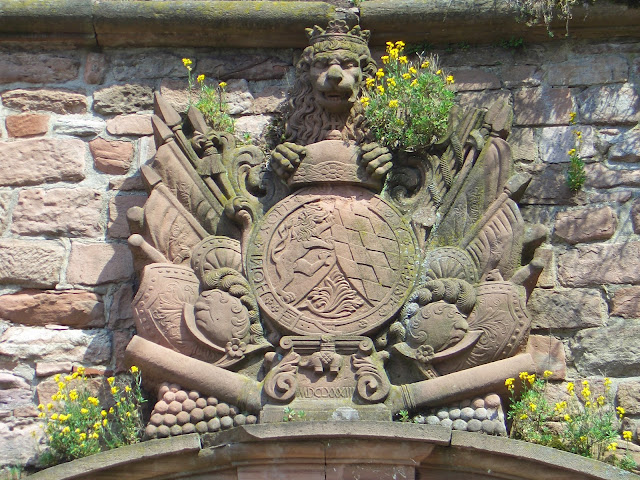 |
| City walls surrounding much of Weil der Stadt |
 |
| Weil der Stadt Coat of Arms Eagle: Free Imperial City SPQR: Roman Senate & People Keys: Catholic Church, as on Vatican Flag |
Forty minutes via the S6 local train from Stuttgart, we arrived at Weil der Stadt, located in the green Wurm Valley on the Württemberg side of the enchanting Black Forest. Also situated in the Greater Stuttgart Region, more specifically Kreis (County) Böblingen, Weil der Stadt with its present name dates back to medieval times. Spared much damage during the Second World War, the town remains original, proudly boasting memorials to her famous sons Johannis Kepler, the renowned early 17th-century astronomer, and Johannis Brenz (They aren't real original on first names are they?), a student of Martin Luther and who was instrumental in bringing the Reformation to Württemberg, although oddly enough after the Reformation, Weil der Stadt remained a Catholic city. Brenz died in 1570, the year before Kepler was born. Evidently, the bombardment of the town by the French military during WWII was called off in respect to the fact that this is the birthplace of that famous astronomer. To think that a person who had been dead some 300 odd years saved his town from destruction says loads.
 |
| One a several original towers still remaining in the walls |
Upon arrival, the town is indeed immediately impressive in its historical architectural vestments which outnumber anything more modern located there. This of course pleases your writer very much. Fachwerkhäuser are in abundance; so much so, that for one of the rare times in my life, I didn't bother trying to capture every one of them on film.
 |
| Narrenzunft or Fools' Guildhall |
I found very interesting the origin of the town's name. Evidently, 'Weil' emerged from the Latin word vila/villa, which not only referred to a town, but also perhaps a manor/estate of sorts which originated any settlement here. (This is how I understood it in any case.) Long after the Romans were gone, 'Weil' was evidently granted the status of Stadt, which means town or city in German. 'der' is the feminine possessive 'of the', so Weil of the Town/City (Weil der Stadt) came about to distinguish this particular 'Weil' from Weil im Dorf (Weil in the Village), for example.
 |
| Holding the emblem of the Free Imperial City of Weil der Stadt |
As many of you may already be aware, vast swathes of Germany were part of the Roman Empire many centuries ago, so its Roman heritage traces are not uncommon at all here. Weil der Stadt once belonged to the powerful Abbey of Hirsau, which I reported on earlier. This was in the first half of the 11th century. Later, Weil der Stadt was to become a Free Imperial City, granting it special trade and military rights amongst other things.
In 1648, Weil der Stadt was utterly destroyed in the Thirty-Years War and was rebuilt into what we see today. It is dominated by its massive St. Peter and St. Paul Catholic church located in the center of town, where a statue in honor of Johannis Kepler can be seen.
The wall and towers of the city, so much of what still remain today, are what impress me the most. A walk around the outside as well as parts of the inside (where the wall doesn't actually constitute one of the walls of an interior building) give a good idea of how and for what city walls were used, even today.
 |
| Tower of the Church of St. Peter and St. Paul rises behind the Marktplatz statue of Weil der Stadt's most renowned son, the astronomer Johannis Kepler. |
Weil der Stadt is also home to some of the ancient guilds which, although perhaps changed in their modern-day functions, proudly continue to operate, for example in the Narrenzunft, or Fools' Guild here in town. As Carnival is very important here and wonderfully celebrated with a colorful and historic parade of ancient carnival costumes, it would be worth the visit during the Carnival season. The parade itself is held at Fastnacht, or as the locals would say in their Swabian dialect, Fastnet. Visit my report on this topic during the Europe-wide celebration of Narrenfest that took place in Bad Cannstatt some years ago. Participants from the guilds of Weil der Stadt were indeed represented during that brilliant event!
I highly recommend a visit to Weil der Stadt. If you can be there during Fastnet, you will have an experience and loads of photos that you will likely never forget; however, plan carefully for any visit because it is only on one day and the crowds are large. Still, it would be absolutely worth it. Any other time of the year to visit would also be rewarding. Its proximity to Stuttgart via train or car is convenient and only about 20 miles (approx. 30 kilometers) away. It is easily a day trip or less.
Click here to see an Aerial video of Weil der Stadt. You will be able to get a better idea of how small the town is and get a nice view from above.
How to get there:
From Stuttgart via train, take the S6 from underground at the main station in the direction of Weil der Stadt. If all is running on time, it should be just under 40 minutes.
From Stuttgart via car, head out west of the city on the B14 and follow the signs to Weil der Stadt. Altogether, traffic aside (based on traffic patterns in 2016), it should take under 40 minutes.




.JPG)

.jpg)
.jpg)

































